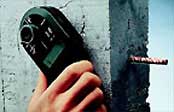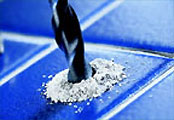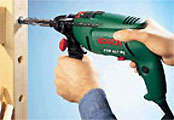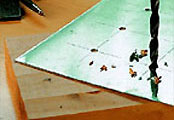 |
 |
 |
Hints & Tips |
 |
 |
|
|
|
 |
|
 |
|
Exercising care around pipes and
cables
Before drilling in a wall, always establish whether pipes and
cables run where you plan to drill. For this purpose we
recommend using the  metal
finder from BOSCH. metal
finder from BOSCH. |
 |
 |
|
 |
|
Deep, dust-free holes for fixings
When using  plastic
fixings you should make the hole slightly deeper than the
length of the fixing. Ten millimetres is a good security reserve
in the event that drilling dust should remain in the fixing
hole. You can blow into the hole yourself. When doing so, keep
your eyes closed - or simply use the plastic
fixings you should make the hole slightly deeper than the
length of the fixing. Ten millimetres is a good security reserve
in the event that drilling dust should remain in the fixing
hole. You can blow into the hole yourself. When doing so, keep
your eyes closed - or simply use the  dust
blower from BOSCH. If you prefer to remove the dust with
suction, use your vacuum cleaner. dust
blower from BOSCH. If you prefer to remove the dust with
suction, use your vacuum cleaner. |
 |
 |
|
 |
|
Drill more lightly into metal
When drilling flat surfaces like metal, it is easy for the drill
bit to slide from the desired spot, preventing you from starting
the hole where you want it. To keep this from happening,
manually make a small hole in the metal before drilling. The
most common tool for this task is called a punch, a metal rod
that has a flat surface on one end (for striking with a hammer),
and a point on the other end. After making the hole, it will be
much easier for you to get off to a clean start with the drill.
When drilling in very hard material, you may wish to start
drilling the hole with a thin drill bit and then finish the hole
with a drill bit of the desired diameter. |
|
|
 |
|
 |
|
Hold the drill properly
Always hold the impact drill straight and apply pressure
perpendicularly to the surface of the wall or object. If you use
the auxiliary handle, your job will be easier because the handle
gives you better control whilst drilling. The  drilling
angle controller makes it even easier. For example,
you can place this device directly onto the work piece and then
easily drill a hole that is exactly vertical. But if you would
like to drill at an angle, you will do this with equal
precision. You can adjust the controller to drill at an angle as
narrow as 15 degrees. drilling
angle controller makes it even easier. For example,
you can place this device directly onto the work piece and then
easily drill a hole that is exactly vertical. But if you would
like to drill at an angle, you will do this with equal
precision. You can adjust the controller to drill at an angle as
narrow as 15 degrees. |
 |
 |
|
 |
|
Sensitive acrylic glass
When drilling in acrylic glass, always drill at low speed. This
material is very sensitive to heat and may otherwise melt. |
 |
 |
|
 |
|
Plaster for tiles
Here is an old craftsman's trick: Drill bits tend to slide from
smooth tiles, but you can prevent this by placing adhesive
plaster or a piece of tape onto the spot where you plan to
drill. |
|
|
 |
|
 |
|
Drive screws with the right bit
If you use the improper  bits,
you will quickly destroy the screw head. For this reason, it is
important to choose not only the proper bit shape (slotted,
cross head, Allen, or Torx), but also the proper bit size. bits,
you will quickly destroy the screw head. For this reason, it is
important to choose not only the proper bit shape (slotted,
cross head, Allen, or Torx), but also the proper bit size. |
 |
 |
 |
 |
 |
 |
 |